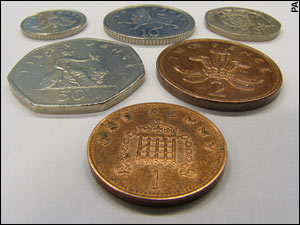Deciphering British Humor: Currency
 I strive to understand the humor of other cultures because I honestly believe being able to laugh along with the rest of humanity is the key to the eventual unity of the species… but that aside, while British humor should, in theory, be easily accessible by Americans, there are parts of it that are all but in-decipherable by we “Yanks”. For me, the Byzantine mysteries of their currency is first and foremost among these divisions. Ive scoured the source material and interrogated a few of the less belligerent ex-patriots I’ve come across. This is the quick reference guide I’ve come across.
I strive to understand the humor of other cultures because I honestly believe being able to laugh along with the rest of humanity is the key to the eventual unity of the species… but that aside, while British humor should, in theory, be easily accessible by Americans, there are parts of it that are all but in-decipherable by we “Yanks”. For me, the Byzantine mysteries of their currency is first and foremost among these divisions. Ive scoured the source material and interrogated a few of the less belligerent ex-patriots I’ve come across. This is the quick reference guide I’ve come across.
The British despise the Euro. It is only accepted for novelty purposes and even then, under no circumstances will a British shopkeeper accept Euros from the French or Germans.
Prior to 1971, the relationship of the various British monies were each respectively a function of Hyper-dimensional Imaginary Reverse Calculus. While Americans were collectively recovering from the “Psychedelic 60s”, the British discovered the concept of Base 10 and Decimals which slightly improved matters.
The system of currency prior to 1971 is also known as the Golden Age of monetary humor in Britain and went something like this:
The Pound: Supposedly the official currency of Great Britain. Sometimes called a “crown”, “farthing”, and the “sovereign” depending on the type (coin or paper note), composition of the money (gold, silver, bone, clay, coal, wood, tea or sheep) and finally what is on the coin (revered monarch, plant, animal, obscure national figure or bad Latin). The Guinea is worthy slightly more than a pound because of the popular habit of giving away a free Guineafowl with each Pound that arose after the British Empire’s expanded colonial presence in Africa. The nickname “Quid” is equivalent to the American “Buck” (used for Dollar) and is a reference to the fictional game of Quidditch to honor J.K. Rowling’s literary achievements. For Americans its probably easiest to mentally transpose “Pound” with “Dollar”, but this should never be verbalized as it will lead to violent objections from nearby Britains about conversion rates.
The Shilling: Well, its a coin. For the sake of Americans think of something more substantial than a penny but not as useful as a quarter. Its roughly the amount that retailers discount a round-number price to attempt to convince consumers that they are getting a “good deal”. Prior to the 16th century, the number of Shillings in a Pound was directly related to the weight of the reigning monarch. This practice was abandoned upon the death of Henry the VIII when the conversion rate resulted in near economic collapse. After the 16th century, Depending on the era or temperature, there are Pi or 20 Shillings in a Pound.
The Penny/Pence: Sometimes called “P”, this coin never fails to get a juvenile laugh from Americans. If its variations are any indications, it can be assumed that it is the most common coin in the entire British Empire. The Penny family also includes: Three-Half Pence, HalfPenny (ha’penny), Threepence (“thripp’nce”, “thrupp’nce”, “threpp’nce” or “thripp’ny bit”, “thrupp’ny bit”) and possibly the Groat. This entire family of coins exists to enliven British folks songs and pay non-English laborers prior to 1899.
The Farthing: This coin is valued at one-fourth of a Pence and is appropriately the size of a rice grain. It was introduced to make the Pence more masculine seeming. The Farthing family of coins also possibly include the Mite; a coin so unimaginably squalid that anyone that possessed this coin probably also possessed the parasite of the same name. There is strong historical evidence that the Farthing series of coins was invented by Charles DIckens to further illustrate poverty in his critiques of socio-economic conditions.
Hope this helps. PS – Feel free to add anything above to Wikipedia (with Citation).






